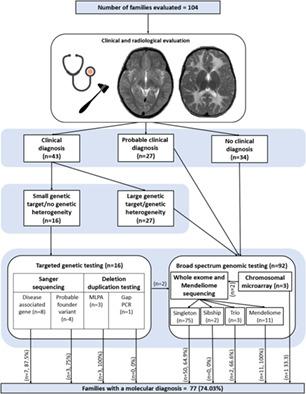当前位置:
X-MOL 学术
›
Clin. Genet.
›
论文详情
Our official English website, www.x-mol.net, welcomes your
feedback! (Note: you will need to create a separate account there.)
Clinical and genetic spectrum of 104 Indian families with central nervous system white matter abnormalities
Clinical Genetics ( IF 2.9 ) Pub Date : 2021-07-24 , DOI: 10.1111/cge.14037 Parneet Kaur 1 , Michelle C do Rosario 1 , Malavika Hebbar 1 , Suvasini Sharma 2 , Neethukrishna Kausthubham 1 , Karthik Nair 1 , Shrikiran A 3 , Ramesh Bhat Y 3 , Leslie Edward S Lewis 3 , Sheela Nampoothiri 4 , Siddaramappa J Patil 5 , Narayanaswami Suresh 2 , Sunita Bijarnia Mahay 6 , Ratna Dua Puri 6 , Shivanand Pai 7 , Anupriya Kaur 8 , Rakshith Kc 7 , Nutan Kamath 9 , Shruti Bajaj 10 , Ali Kumble 11 , Rajesh Shetty 12 , Rathika Shenoy 13 , Mahesh Kamate 14 , Hitesh Shah 15 , Mamta N Muranjan 16 , Yatheesha Bl 17 , K Shreedhara Avabratha 18 , Girish Subramaniam 19 , Rajagopal Kadavigere 20 , Stephanie Bielas 21 , Katta Mohan Girisha 1 , Anju Shukla 1
Clinical Genetics ( IF 2.9 ) Pub Date : 2021-07-24 , DOI: 10.1111/cge.14037 Parneet Kaur 1 , Michelle C do Rosario 1 , Malavika Hebbar 1 , Suvasini Sharma 2 , Neethukrishna Kausthubham 1 , Karthik Nair 1 , Shrikiran A 3 , Ramesh Bhat Y 3 , Leslie Edward S Lewis 3 , Sheela Nampoothiri 4 , Siddaramappa J Patil 5 , Narayanaswami Suresh 2 , Sunita Bijarnia Mahay 6 , Ratna Dua Puri 6 , Shivanand Pai 7 , Anupriya Kaur 8 , Rakshith Kc 7 , Nutan Kamath 9 , Shruti Bajaj 10 , Ali Kumble 11 , Rajesh Shetty 12 , Rathika Shenoy 13 , Mahesh Kamate 14 , Hitesh Shah 15 , Mamta N Muranjan 16 , Yatheesha Bl 17 , K Shreedhara Avabratha 18 , Girish Subramaniam 19 , Rajagopal Kadavigere 20 , Stephanie Bielas 21 , Katta Mohan Girisha 1 , Anju Shukla 1
Affiliation

|
Genetic disorders with predominant central nervous system white matter abnormalities (CNS WMAs), also called leukodystrophies, are heterogeneous entities. We ascertained 117 individuals with CNS WMAs from 104 unrelated families. Targeted genetic testing was carried out in 16 families and 13 of them received a diagnosis. Chromosomal microarray (CMA) was performed for three families and one received a diagnosis. Mendeliome sequencing was used for testing 11 families and all received a diagnosis. Whole exome sequencing (WES) was performed in 80 families and was diagnostic in 52 (65%). Singleton WES was diagnostic for 50/75 (66.67%) families. Overall, genetic diagnoses were obtained in 77 families (74.03%). Twenty-two of 47 distinct disorders observed in this cohort have not been reported in Indian individuals previously. Notably, disorders of nuclear mitochondrial pathology were most frequent (9 disorders in 20 families). Thirty-seven of 75 (49.33%) disease-causing variants are novel. To sum up, the present cohort describes the phenotypic and genotypic spectrum of genetic disorders with CNS WMAs in our population. It demonstrates WES, especially singleton WES, as an efficient tool in the diagnosis of these heterogeneous entities. It also highlights possible founder events and recurrent disease-causing variants in our population and their implications on the testing strategy.
中文翻译:

104个印度中枢神经系统白质异常家庭的临床和遗传谱
以中枢神经系统白质异常 (CNS WMA) 为主的遗传性疾病,也称为脑白质营养不良,是异质实体。我们从 104 个无关家庭中确定了 117 名 CNS WMA 患者。对16个家庭进行了针对性基因检测,其中13个家庭得到诊断。对三个家庭进行了染色体微阵列(CMA)检查,其中一个家庭得到了诊断。门德里组测序用于检测 11 个家庭,所有家庭都得到了诊断。对 80 个家庭进行了全外显子组测序 (WES),并对 52 个家庭 (65%) 进行了诊断。 Singleton WES 对 50/75 (66.67%) 的家庭具有诊断意义。总体而言,77个家庭(74.03%)获得了基因诊断。在该队列中观察到的 47 种不同疾病中有 22 种以前从未在印度个体中报告过。值得注意的是,核线粒体病理学疾病最为常见(20 个家族中有 9 种疾病)。 75 个致病变异中有 37 个 (49.33%) 是新的。综上所述,本队列描述了我们人群中 CNS WMA 遗传性疾病的表型和基因型谱。它证明了 WES,尤其是单例 WES,是诊断这些异构实体的有效工具。它还强调了我们人群中可能的创始人事件和复发性致病变异及其对检测策略的影响。
更新日期:2021-07-24
中文翻译:

104个印度中枢神经系统白质异常家庭的临床和遗传谱
以中枢神经系统白质异常 (CNS WMA) 为主的遗传性疾病,也称为脑白质营养不良,是异质实体。我们从 104 个无关家庭中确定了 117 名 CNS WMA 患者。对16个家庭进行了针对性基因检测,其中13个家庭得到诊断。对三个家庭进行了染色体微阵列(CMA)检查,其中一个家庭得到了诊断。门德里组测序用于检测 11 个家庭,所有家庭都得到了诊断。对 80 个家庭进行了全外显子组测序 (WES),并对 52 个家庭 (65%) 进行了诊断。 Singleton WES 对 50/75 (66.67%) 的家庭具有诊断意义。总体而言,77个家庭(74.03%)获得了基因诊断。在该队列中观察到的 47 种不同疾病中有 22 种以前从未在印度个体中报告过。值得注意的是,核线粒体病理学疾病最为常见(20 个家族中有 9 种疾病)。 75 个致病变异中有 37 个 (49.33%) 是新的。综上所述,本队列描述了我们人群中 CNS WMA 遗传性疾病的表型和基因型谱。它证明了 WES,尤其是单例 WES,是诊断这些异构实体的有效工具。它还强调了我们人群中可能的创始人事件和复发性致病变异及其对检测策略的影响。











































 京公网安备 11010802027423号
京公网安备 11010802027423号